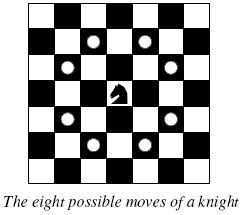转载请注明出处:http://blog.csdn.net/u012860063?viewmode=contents
id=2488
----------------------------------------------------------------------------------------------------------------------------------------------------------
欢迎光临天资小屋:http://user.qzone.qq.com/593830943/main
----------------------------------------------------------------------------------------------------------------------------------------------------------
Description
 Background
Background The knight is getting bored of seeing the same black and white squares again and again and has decided to make a journey
around the world. Whenever a knight moves, it is two squares in one direction and one square perpendicular to this. The world of a knight is the chessboard he is living on. Our knight lives on a chessboard that has a smaller area than a regular 8 * 8 board, but it is still rectangular. Can you help this adventurous knight to make travel plans?
Problem
Find a path such that the knight visits every square once. The knight can start and end on any square of the board.
Input
The input begins with a positive integer n in the first line. The following lines contain n test cases. Each test case consists of a single line with two positive integers p and q, such that 1 <= p * q <= 26. This represents a p * q chessboard, where p describes
how many different square numbers 1, . . . , p exist, q describes how many different square letters exist. These are the first q letters of the Latin alphabet: A, . . .
Output
The output for every scenario begins with a line containing "Scenario #i:", where i is the number of the scenario starting at 1. Then print a single line containing the lexicographically first path that visits all squares of the chessboard with knight moves
followed by an empty line. The path should be given on a single line by concatenating the names of the visited squares. Each square name consists of a capital letter followed by a number.
If no such path exist, you should output impossible on a single line.
If no such path exist, you should output impossible on a single line.
Sample Input
3 1 1 2 3 4 3
Sample Output
Scenario #1: A1 Scenario #2: impossible Scenario #3: A1B3C1A2B4C2A3B1C3A4B2C4
大致题意:
给出一个国际棋盘的大小,推断马是否能不反复的走过全部格,并记录下当中按字典序排列的第一种路径。
代码例如以下:
#include <cstdio>
#include <cstring>
#define M 26
struct node
{
int x, y;
}w[M*M];
bool vis[M][M];
int p, q;
int flag = 0;
int dir[8][2]={{-2,-1},{-2,1},{-1,-2},{-1,2},{1,-2},{1,2},{2,-1},{2,1}};
//按此顺序搜索出来的结果就是字典序
bool judge(int x, int y)
{
if(x>=0&&x<q&&y>=0&&y<p&&!vis[x][y])
return true;
return false;
}
void dfs(int x, int y, int step)
{
w[step].x = x,w[step].y = y;
vis[x][y] = true;
if(step == p*q-1)
{
flag = 1;
return ;
}
for(int i = 0; i < 8; i++)
{
int dx = w[step].x+dir[i][0];
int dy = w[step].y+dir[i][1];
if(judge(dx,dy))
{
vis[dx][dy] = true;
dfs(dx,dy,step+1);
if(flag)//一但找到就退出搜索
return;
vis[dx][dy] = false;
}
}
return ;
}
void print()
{
for(int i = 0; i < p*q; i++)//列为字母,行为数字
{
printf("%c%d",w[i].x+'A',w[i].y+1);
}
printf("
");
}
int main()
{
int t, i, j, cas = 0;
scanf("%d",&t);
while(t--)
{
memset(vis,false,sizeof(vis));
flag = 0;
scanf("%d%d",&p,&q);
for(i = 0; i < q; i++)//列
{
for(j = 0; j < p; j++)//行
{
dfs(i,j,0);
if(flag)
break;
}
if(flag)
break;
}
printf("Scenario #%d:
",++cas);
if(flag)
print();
else
printf("impossible
");
}
return 0;
}